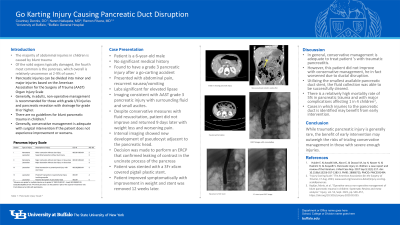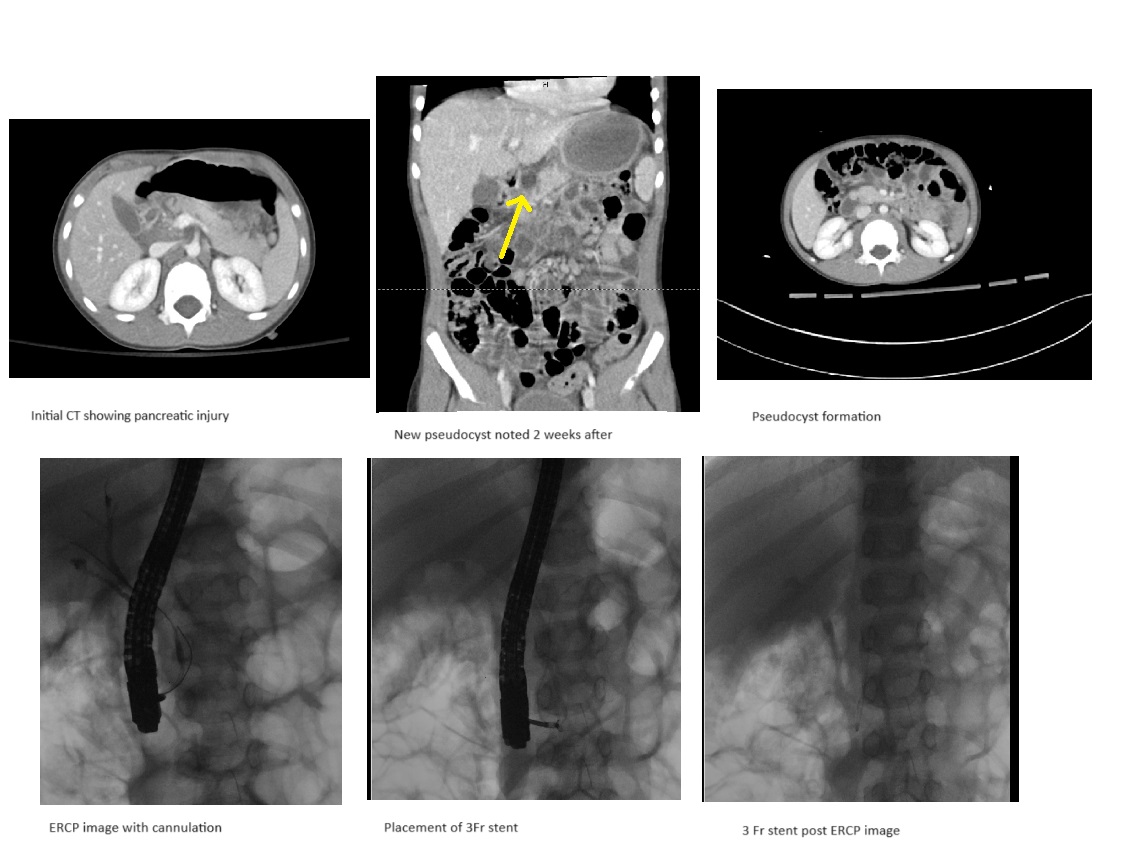Sunday Poster Session
Category: Pediatrics
P1476 - Go-karting Injury Causing Pancreatic Duct Disruption
Sunday, October 27, 2024
3:30 PM - 7:00 PM ET
Location: Exhibit Hall E

Has Audio

Courtney Dennis, DO
University at Buffalo
Amherst, NY
Presenting Author(s)
Courtney Dennis, DO, Naren Nallapeta, MD, Ramon Rivera, MD
University at Buffalo, Buffalo, NY
Introduction: The majority of abdominal injuries in children are caused by blunt trauma. Of the solid organs typically damaged, the 4th most common is the pancreas, which overall is relatively uncommon at 2-9% of cases.1 Pancreatic injuries can be divided into minor and major based on the American Association for the Surgery of Trauma (AAST) Organ Injury Scale. AAST I/II injuries refer to parenchymal injuries without pancreatic duct involvement. AAST III/IV/V include ductal injuries with laceration or transection.2 Generally, in adults, non-operative management is recommended in grade I/II injuries and pancreatic resection with drainage in grade III or higher. There are no guidelines for children.3 Often, conservative management is adequate with surgical intervention if the patient does not experience improvement or worsens. Unfortunately, given the relative rarity of traumatic pancreatic injuries, management can be challenging.
Case Description/Methods: Patient is a 6-year-old male without significant medical history who was found to have a grade III pancreatic injury after a go-karting accident where he was an un-belted driver traveling at 15-20 mph when he ran into a bush in front of a building wall. He presented with abdominal pain, recurrent nausea/vomiting, labs significant for elevated lipase, and imaging consistent with AAST grade III pancreatic injury with surrounding fluid and small ascites. Despite conservative measures, patient did not improve and returned 9 days later with weight loss and worsening pain. Interval imaging showed new development of pseudocyst adjacent to the pancreatic head. Decision was made to perform an ERCP which confirmed leaking of contrast in the uncinate process of the pancreas. This was stented with a 3Frx6cm covered pigtail plastic stent. Patient improved symptomatically with improvement in weight and the stent passed 12 weeks later.
Discussion: In general, conservative management is adequate to treat patient‘s with traumatic pancreatitis. However, this patient did not improve, he in fact worsened, likely due to ductal disruption. Conservative management was further impeded as he was unable to eat or drink due to his fluid collection. Utilizing the smallest available pancreatic duct stent, the fluid collection was able to be successfully cleared. Given the relatively high mortality rate of 5% in pancreatic trauma and with major complications affecting 1 in 4 children3, the benefit of early intervention may outweigh the risk of only conservatively treating in select cases.

Disclosures:
Courtney Dennis, DO, Naren Nallapeta, MD, Ramon Rivera, MD. P1476 - Go-karting Injury Causing Pancreatic Duct Disruption, ACG 2024 Annual Scientific Meeting Abstracts. Philadelphia, PA: American College of Gastroenterology.
University at Buffalo, Buffalo, NY
Introduction: The majority of abdominal injuries in children are caused by blunt trauma. Of the solid organs typically damaged, the 4th most common is the pancreas, which overall is relatively uncommon at 2-9% of cases.1 Pancreatic injuries can be divided into minor and major based on the American Association for the Surgery of Trauma (AAST) Organ Injury Scale. AAST I/II injuries refer to parenchymal injuries without pancreatic duct involvement. AAST III/IV/V include ductal injuries with laceration or transection.2 Generally, in adults, non-operative management is recommended in grade I/II injuries and pancreatic resection with drainage in grade III or higher. There are no guidelines for children.3 Often, conservative management is adequate with surgical intervention if the patient does not experience improvement or worsens. Unfortunately, given the relative rarity of traumatic pancreatic injuries, management can be challenging.
Case Description/Methods: Patient is a 6-year-old male without significant medical history who was found to have a grade III pancreatic injury after a go-karting accident where he was an un-belted driver traveling at 15-20 mph when he ran into a bush in front of a building wall. He presented with abdominal pain, recurrent nausea/vomiting, labs significant for elevated lipase, and imaging consistent with AAST grade III pancreatic injury with surrounding fluid and small ascites. Despite conservative measures, patient did not improve and returned 9 days later with weight loss and worsening pain. Interval imaging showed new development of pseudocyst adjacent to the pancreatic head. Decision was made to perform an ERCP which confirmed leaking of contrast in the uncinate process of the pancreas. This was stented with a 3Frx6cm covered pigtail plastic stent. Patient improved symptomatically with improvement in weight and the stent passed 12 weeks later.
Discussion: In general, conservative management is adequate to treat patient‘s with traumatic pancreatitis. However, this patient did not improve, he in fact worsened, likely due to ductal disruption. Conservative management was further impeded as he was unable to eat or drink due to his fluid collection. Utilizing the smallest available pancreatic duct stent, the fluid collection was able to be successfully cleared. Given the relatively high mortality rate of 5% in pancreatic trauma and with major complications affecting 1 in 4 children3, the benefit of early intervention may outweigh the risk of only conservatively treating in select cases.

Figure: CT and ERCP imaging
Disclosures:
Courtney Dennis indicated no relevant financial relationships.
Naren Nallapeta indicated no relevant financial relationships.
Ramon Rivera indicated no relevant financial relationships.
Courtney Dennis, DO, Naren Nallapeta, MD, Ramon Rivera, MD. P1476 - Go-karting Injury Causing Pancreatic Duct Disruption, ACG 2024 Annual Scientific Meeting Abstracts. Philadelphia, PA: American College of Gastroenterology.
